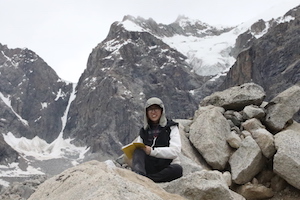Friday October 2, 2020 • Zoom TBA
3:00 PM - 4:00 PM

Dr. Nancy Li, Department of Geography, Texas State University
As a reliable and unequivocal indicator of climate change, mountain glaciers signify the most in regions with limited precipitation, such as arid and semi-arid Central Asia. The high concentration of glaciers and meltwater from the Tian Shan contribute considerably to the freshwater resource in Xinjiang (China), Kyrgyzstan, and nearby countries. Relying on the cosmogenic nuclide exposure dating, the timing and extent of the Little Ice Age glacial activities were discovered across the mountain range. Coming out of the extensive cold periods, modern techniques, like remote sensing and small unmanned aerial vehicles, help to reveal the shrinking glaciers with a fine temporal and spatial resolution in the context of the warming climate. This work provides insight into discussing the relationship between climate and glacier responses and these regional records are important to contributing our understanding of the global pattern at large.
For more information, please visit the Department of Geography & the Environment.

No comments:
Post a Comment
Note: Only a member of this blog may post a comment.